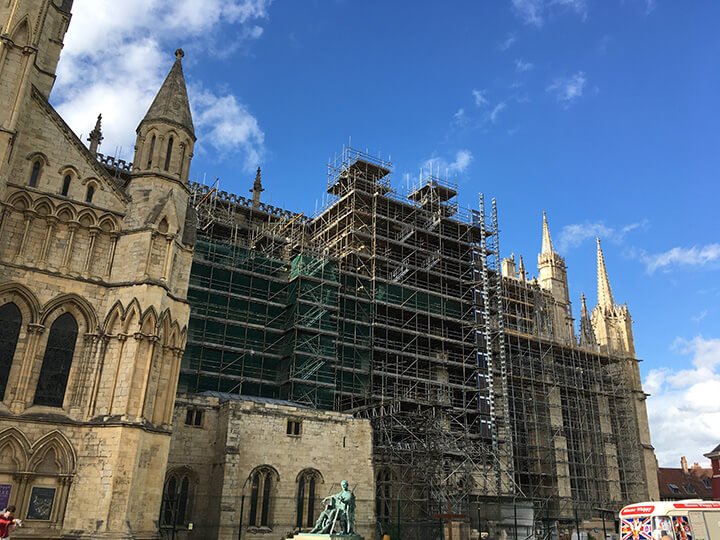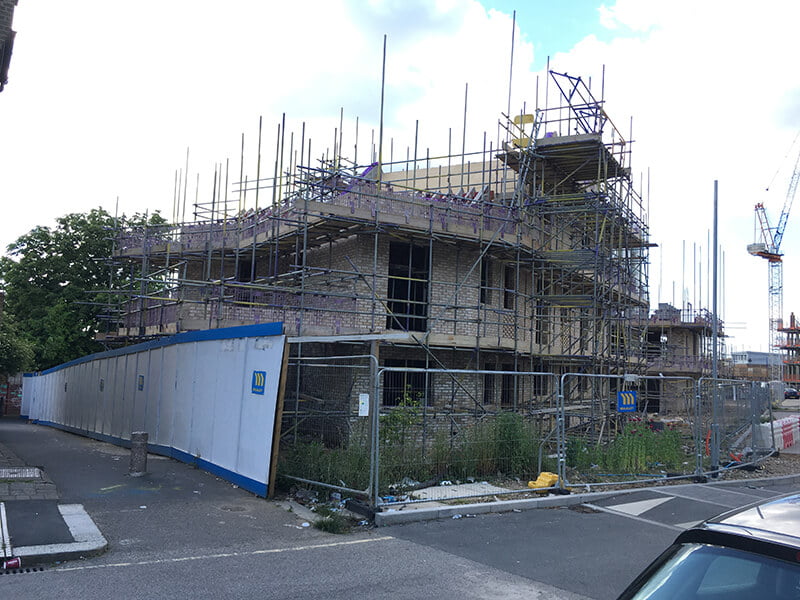System scaffolding is a scaffold that incorporates vertical posts, and horizontal and diagonal tubes. The posts have connection points where they’re fixed at intervals, and the horizontal and diagonal tubes can easily be connected to the framework.
System scaffold is also known as modular scaffolding, it is a prefabricated scaffold that does not require nuts or bolts to tighten during assembly. System scaffolding is easier to assemble and takedown because of the latch mechanism.
The system scaffolding can be designed to include bridges, cantilevers, staircases, beam applications, and protection fans.

Different architecture requires different scaffolding to ensure that there’s easy and safe access when working at height. For this, you’ll find that there are different scaffolding systems used in the construction industry. In the UK the traditional scaffolding used is tube & fitting scaffolding but more scaffolding companies are adopting the use of system scaffold. We’ll look at some of the common system scaffolds and their use in the UK.
The difference between tube & fitting and system scaffolding
The main difference between tube & fitting and system scaffolding is that system scaffolds often have snap-together connections that do not need nuts and bolts to be tightened whereas tube and fitting involve metal tubes of various lengths securely fitted together.
System scaffold erection is easier, hence taking a shorter period due to the latch mechanism used, unlike traditional tube & fitting scaffolds which take a longer duration to find the ideal scaffold design and safely tie the tubes together.
The other difference is that a system scaffold costs more than tube and fitting scaffolding which is quite cost-effective in the UK and it’s also easy to manage and assemble. It makes a suitable choice for projects where space is limited since there won’t be any protruding tubes.

Main types of scaffolding systems used in the UK
These are the main scaffolding systems used by scaffolding contractors in London and the UK.
- Kwikstage
- Cuplok
- Layher
- Haki
1. Kwikstage scaffolding
Quickstage scaffolding is also known as kwikstage. Comes in five parts so assembling and dismantling the kwickstage scaffolding makes it a common option for both small and big construction projects. It is used in commercial and residential projects. Made from galvanised steel, the interlocking scaffold system provides a safe and sturdy platform for construction work. It has non-slip platforms and double guard rails that provide more safety making it convenient for all workers to use. You’ll find it being used in various projects since it can also support heavy loads.
2. Cuplock scaffolding
Cuplock scaffolding is easy to erect since it doesn’t require any nuts and bolts to tighten the horizontals. For this, the standards have a locking cup at every node point that can be easily fastened at one time. It’s sturdy enough to be used in construction works like bridges, houses, chimneys, etc.
This type of system scaffolding has bar accessories that make loading and unloading easy. Unlike other types of scaffolding, cuplock scaffolding offers more long-lasting support and is easier to transport. Although they might be lightweight, they are efficient when it comes to supporting heavy weights.
3. Layher scaffolding system
Apart from being highly regarded, the Layher scaffolding system is one of the versatile system scaffolds you can opt for. Regardless of height, this type of scaffold is designed for one-man assembly.
It also features a rosette that can safely accommodate eight connections with ledgers and transoms connected at right angles. Aside from being lightweight, the Layher scaffold offers safety and stability even when heavy loads are involved.
4. Haki scaffolding
It’s a system that’s used in scaffolding, shoring, and suspended systems. The Haki system comes in various heights that can range from 1.5 metres to two metres and it also has adjustable feet. It also comes with toe boars if necessary and handrails. The system is best suited for renovation projects and any other basic construction work.
There are several options you can consider when it comes to scaffolding especially considering the different nature of each project. The safety and well-being of the workers are usually paramount when selecting a suitable choice. With the various scaffold systems discussed above, you should make a more informed decision.
Other Systems
- Tubular scaffolding uses steel tubes and couplers to create a framework for workers to stand on and perform tasks at heights.
- Cantilever: hangs off a structure or building and is supported by the opposite end, allowing workers to access hard-to-reach areas.
- Painters and Builders, aka Trestle: a horizontal platform supported by two or more A-frame supports, typically used for indoor tasks.
- Putlog features horizontal scaffolding boards supported on ledgers fixed into the wall or building structure.
- Modular: Composed of prefabricated components that can be easily assembled and disassembled, providing flexibility and efficiency in construction projects.

Advantages of using System Scaffolding
One of the advantages of system scaffolding is the simplicity in handling it. This comes from erecting to dismantling once you are done. Despite the costs, it is worth it.
System scaffolding comes prefabricated, meaning no extra tubes will be left lying around. Everything that comes is used in the scaffold structure.
The modular design allows adjusting the scaffold structure to suit your current use more. This could be reducing heights, increasing height, or adjusting when working on staircases.